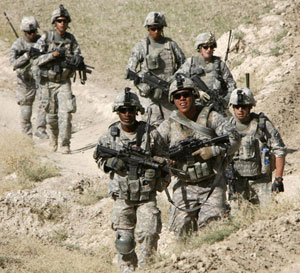|
Public meeting in New York
Saturday, November 7
What Does the Dictatorship of Capital Have in Store for Working People?
(click here for ad)
|
|
(lead article)
U.S. rulers debate
Afghan war strategy

|
|
Reuters/Nikola Solic
|
|
U.S. soldiers on patrol in Logar Province in eastern Afghanistan, October 4.
|
BY SETH GALINSKY
Differences on how to best defend U.S. imperialist interests in Afghanistan and Pakistan have emerged as the White House holds a series of high- level meetings to review U.S. strategy for its increasingly unpopular war in the region. There are Democrats and Republicans, liberals and conservatives, on both sides of the debate.
After turning in a report that described the situation in Afghanistan as serious and “deteriorating,” Gen. Stanley McChrystal, Washington’s top general in Afghanistan, presented three options with varying amounts of troops to back up the military’s “counterinsurgency” strategy. According to the Wall Street Journal, one alternative includes sending more than 60,000 additional troops, although McChrystal reportedly favors sending 40,000.
The troop request follows a shift that has already begun in U.S. military strategy. This includes redeploying troops to more heavily populated areas, promoting some local development projects to undercut support for Taliban and other insurgent forces, and trying to split the insurgency. McChrystal has also ordered U.S. and NATO forces under his command to restrict the use of artillery and air strikes to avoid hitting civilians, a big source of resentment among Afghans.
Vice President Joseph Biden is said to oppose sending more troops and has put forward a competing “counterterrorism” strategy. Under Biden’s proposal Washington would maintain the soon to be 68,000 U.S. troops in Afghanistan. Instead of sending more troops, he proposes stepping up drone attacks on al-Qaeda bases in Pakistan and along the Afghanistan-Pakistan border, conducting more U.S. Special Forces operations there, increasing U.S. aid to the Pakistan military, and downplaying going after Taliban forces in Afghanistan.
Conservative columnist George Will has put forward a similar view.
Chaos-istan
The debate sharpened after McChrystal gave a speech to the International Institute for Strategic Studies in London October 1.
He argued against viewing Afghanistan as “Chaos-istan” and allowing it to become “a Somalia-like haven of chaos that we simply manage from outside.”
Just a few days after McChrystal’s speech, U.S. defense secretary Robert Gates said that advice to the White House should be presented “privately.” Speaker of the House Nancy Pelosi made a similar point in an October 5 interview with PBS’s Charlie Rose. Pelosi says she opposes sending more U.S. troops.
An editorial in the Wall Street Journal highlights the tensions. Some members of the Congressional Democratic Caucus, the editorial said, call McChrystal “General MacArthur,” a reference to the U.S. general in charge of U.S. forces during the Korean war, who was fired by then-president Harry Truman.
Democratic senator Dianne Feinstein, who heads the Senate Intelligence Committee, has come down on McChrystal’s side, saying the U.S. mission in Afghanistan is in “serious jeopardy” and more troops are needed.
U.S. senator and former Republican presidential candidate John McCain, who favors sending 40,000 more troops, has called on Obama to move rapidly to a decision.
Beefing up Afghan army
Gen. David Petraeus, who heads up the U.S. Central Command and has backed McChrystal’s assessment of the war in Afghanistan, noted in an October 7 speech the disagreements in U.S ruling circles on what course to take there. But, he said, all sides agreed on beefing up the Afghan army and police.
The 82,000-strong Afghan army and 134,000 Afghan cops participate in few battles against Taliban and other insurgents.
Washington’s hope to substantially increase the size of the Afghan forces and turn them into an effective fighting force, which it succeeded in doing to some extent with the Iraqi army, has been complicated by the recent presidential elections in Afghanistan.
Two months after the elections, marked by low turnout and charges of massive vote fraud, the results have still not been certified.
Related articles:
Pakistan army plans assault in tribal areas
U.S. commander in chief gets ‘peace’ prize
| 


